Quick filters:
Mycorrhiza roots Stock Photos and Images
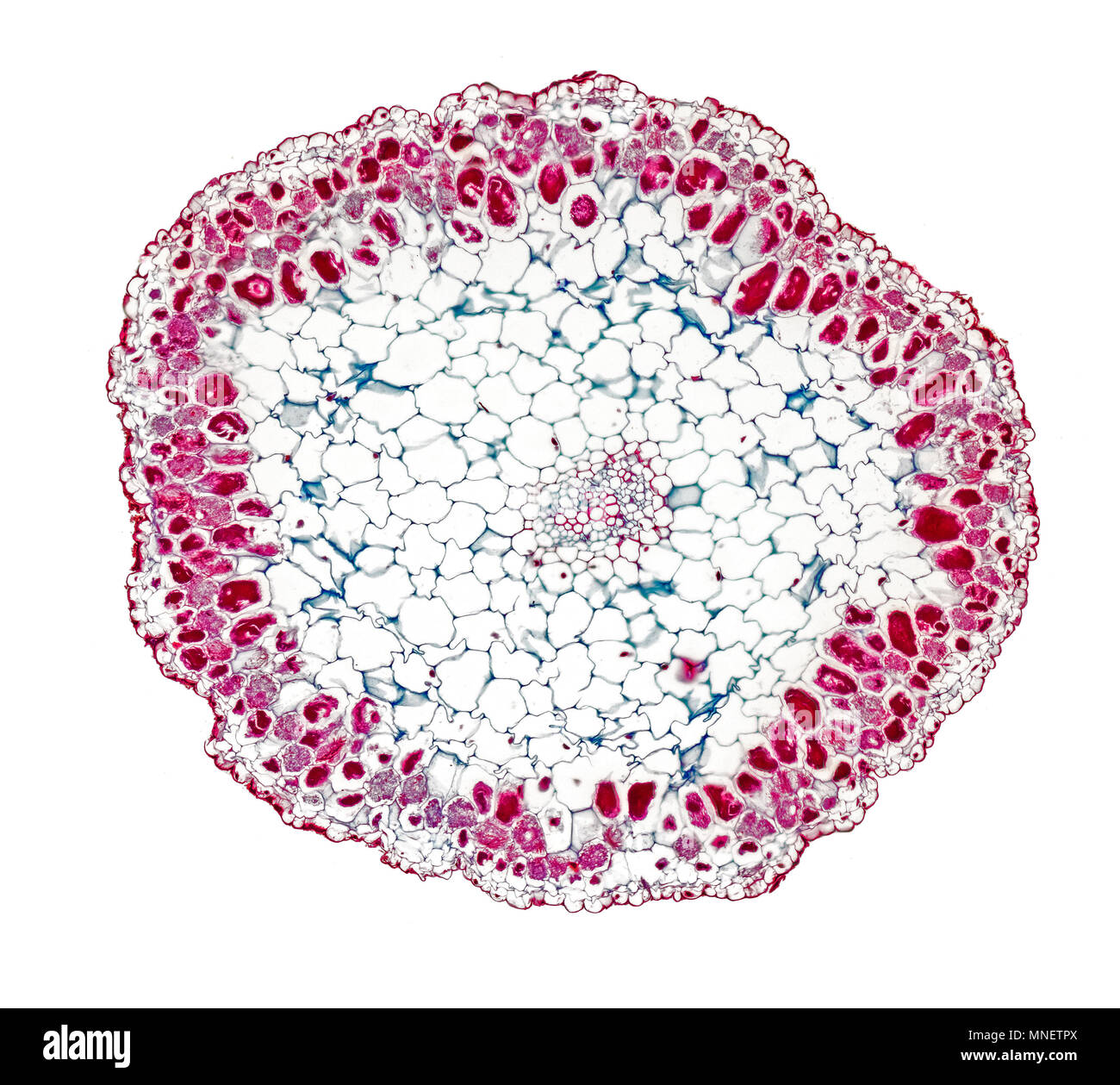 Birds nest orchid root, TS, mycorrhiza is a symbiotic association between a fungus and the roots of a vascular host plant. brightfield photomicrograph Stock Photohttps://www.alamy.com/image-license-details/?v=1https://www.alamy.com/birds-nest-orchid-root-ts-mycorrhiza-is-a-symbiotic-association-between-a-fungus-and-the-roots-of-a-vascular-host-plant-brightfield-photomicrograph-image185338242.html
Birds nest orchid root, TS, mycorrhiza is a symbiotic association between a fungus and the roots of a vascular host plant. brightfield photomicrograph Stock Photohttps://www.alamy.com/image-license-details/?v=1https://www.alamy.com/birds-nest-orchid-root-ts-mycorrhiza-is-a-symbiotic-association-between-a-fungus-and-the-roots-of-a-vascular-host-plant-brightfield-photomicrograph-image185338242.htmlRMMNETPX–Birds nest orchid root, TS, mycorrhiza is a symbiotic association between a fungus and the roots of a vascular host plant. brightfield photomicrograph
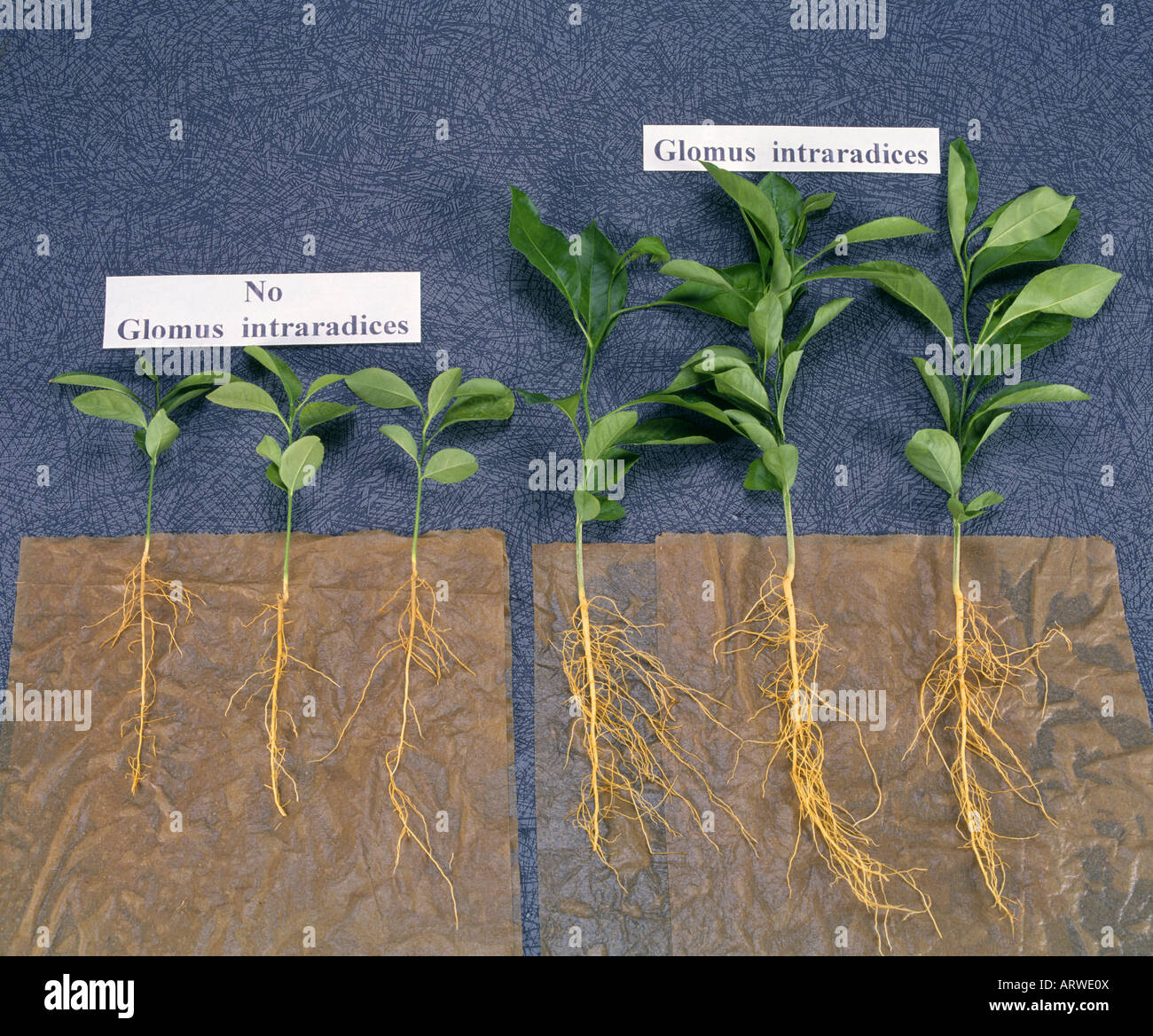 COMPARING ROOT SYSTEMS OF LEMON TREES (ON RIGHT) GROWN WITH MYCORRHIZA AND (ON LEFT) GROWN WITHOUT Stock Photohttps://www.alamy.com/image-license-details/?v=1https://www.alamy.com/stock-photo-comparing-root-systems-of-lemon-trees-on-right-grown-with-mycorrhiza-16133161.html
COMPARING ROOT SYSTEMS OF LEMON TREES (ON RIGHT) GROWN WITH MYCORRHIZA AND (ON LEFT) GROWN WITHOUT Stock Photohttps://www.alamy.com/image-license-details/?v=1https://www.alamy.com/stock-photo-comparing-root-systems-of-lemon-trees-on-right-grown-with-mycorrhiza-16133161.htmlRMARWE0X–COMPARING ROOT SYSTEMS OF LEMON TREES (ON RIGHT) GROWN WITH MYCORRHIZA AND (ON LEFT) GROWN WITHOUT
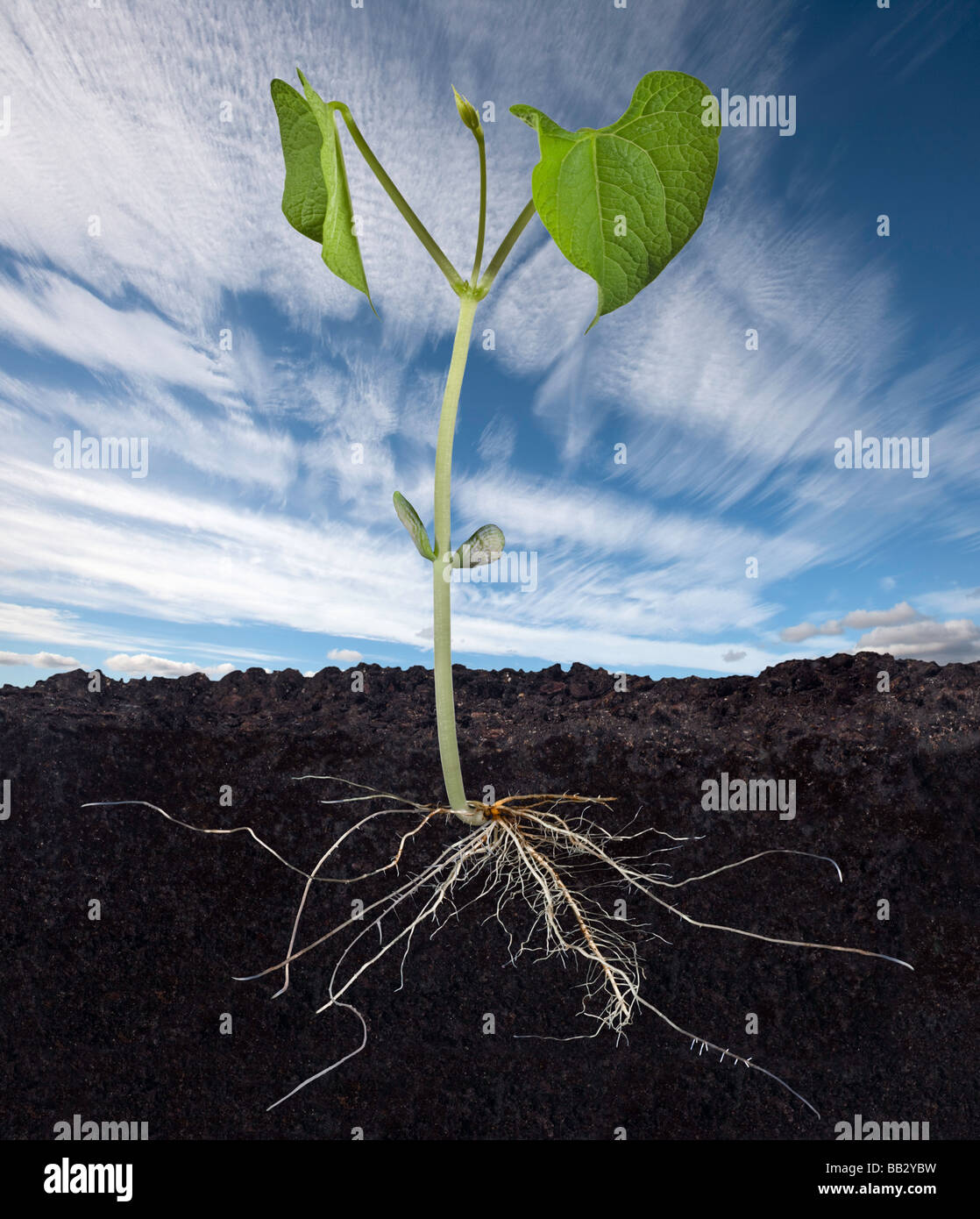 Baby Bean Plant and Root System Stock Photohttps://www.alamy.com/image-license-details/?v=1https://www.alamy.com/stock-photo-baby-bean-plant-and-root-system-24036989.html
Baby Bean Plant and Root System Stock Photohttps://www.alamy.com/image-license-details/?v=1https://www.alamy.com/stock-photo-baby-bean-plant-and-root-system-24036989.htmlRMBB2YBW–Baby Bean Plant and Root System
 Fairy inkcap or fairy bonnet or trooping crumble cap (Coprinellus disseminatus) and male fern (Dryopteris filix-mas) leaves in a beech forest, Hungary Stock Photohttps://www.alamy.com/image-license-details/?v=1https://www.alamy.com/fairy-inkcap-or-fairy-bonnet-or-trooping-crumble-cap-coprinellus-disseminatus-and-male-fern-dryopteris-filix-mas-leaves-in-a-beech-forest-hungary-image593830006.html
Fairy inkcap or fairy bonnet or trooping crumble cap (Coprinellus disseminatus) and male fern (Dryopteris filix-mas) leaves in a beech forest, Hungary Stock Photohttps://www.alamy.com/image-license-details/?v=1https://www.alamy.com/fairy-inkcap-or-fairy-bonnet-or-trooping-crumble-cap-coprinellus-disseminatus-and-male-fern-dryopteris-filix-mas-leaves-in-a-beech-forest-hungary-image593830006.htmlRF2WE386E–Fairy inkcap or fairy bonnet or trooping crumble cap (Coprinellus disseminatus) and male fern (Dryopteris filix-mas) leaves in a beech forest, Hungary
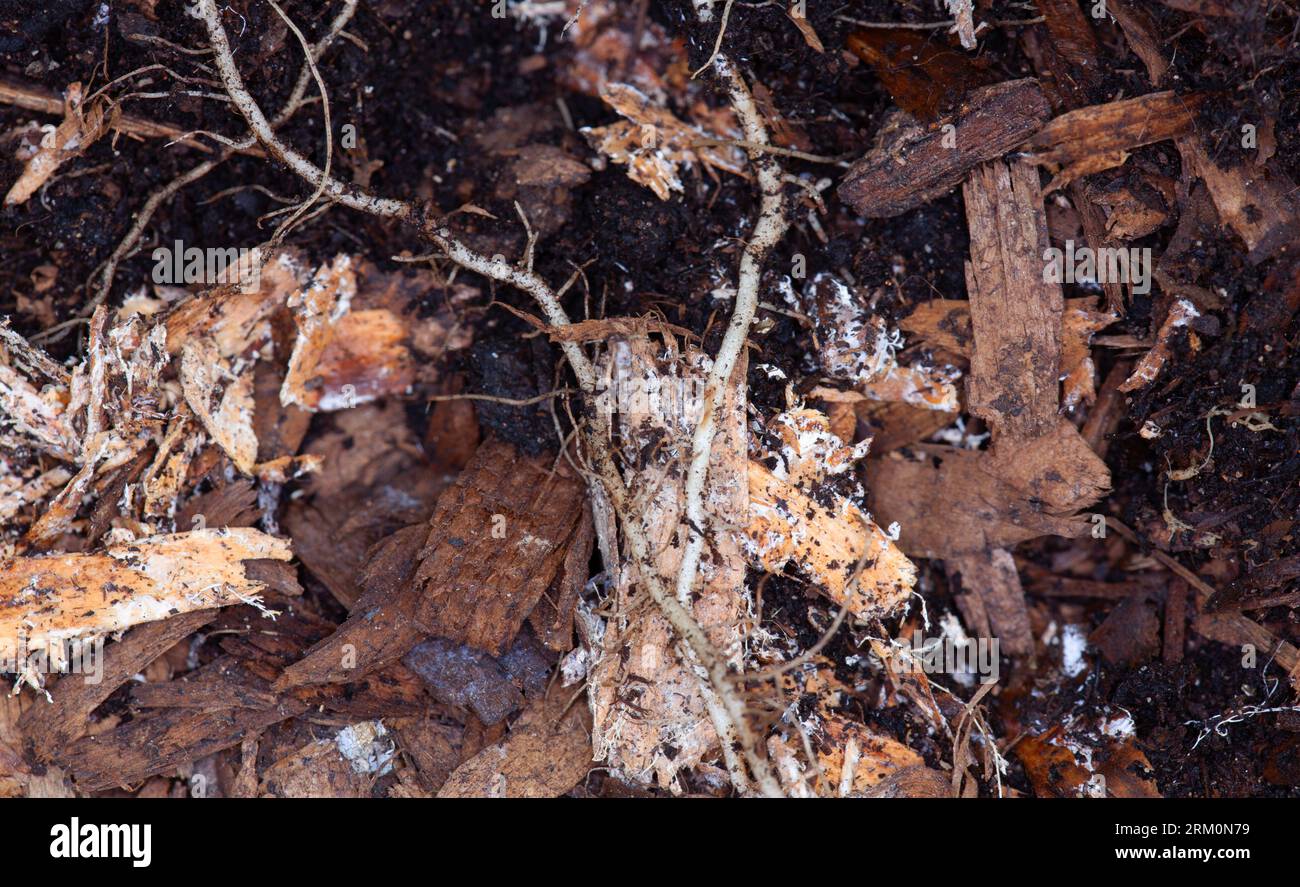 Mycelium Strands around Tomato roots in No Dig compost Stock Photohttps://www.alamy.com/image-license-details/?v=1https://www.alamy.com/mycelium-strands-around-tomato-roots-in-no-dig-compost-image563041565.html
Mycelium Strands around Tomato roots in No Dig compost Stock Photohttps://www.alamy.com/image-license-details/?v=1https://www.alamy.com/mycelium-strands-around-tomato-roots-in-no-dig-compost-image563041565.htmlRF2RM0N79–Mycelium Strands around Tomato roots in No Dig compost
 Branching threads of fungus mycelium spreading over organic soil. A mycorrhizal symbiotic organism which interacts with plant and tree roots, Berkshi Stock Photohttps://www.alamy.com/image-license-details/?v=1https://www.alamy.com/branching-threads-of-fungus-mycelium-spreading-over-organic-soil-a-mycorrhizal-symbiotic-organism-which-interacts-with-plant-and-tree-roots-berkshi-image600614759.html
Branching threads of fungus mycelium spreading over organic soil. A mycorrhizal symbiotic organism which interacts with plant and tree roots, Berkshi Stock Photohttps://www.alamy.com/image-license-details/?v=1https://www.alamy.com/branching-threads-of-fungus-mycelium-spreading-over-organic-soil-a-mycorrhizal-symbiotic-organism-which-interacts-with-plant-and-tree-roots-berkshi-image600614759.htmlRM2WW4A73–Branching threads of fungus mycelium spreading over organic soil. A mycorrhizal symbiotic organism which interacts with plant and tree roots, Berkshi
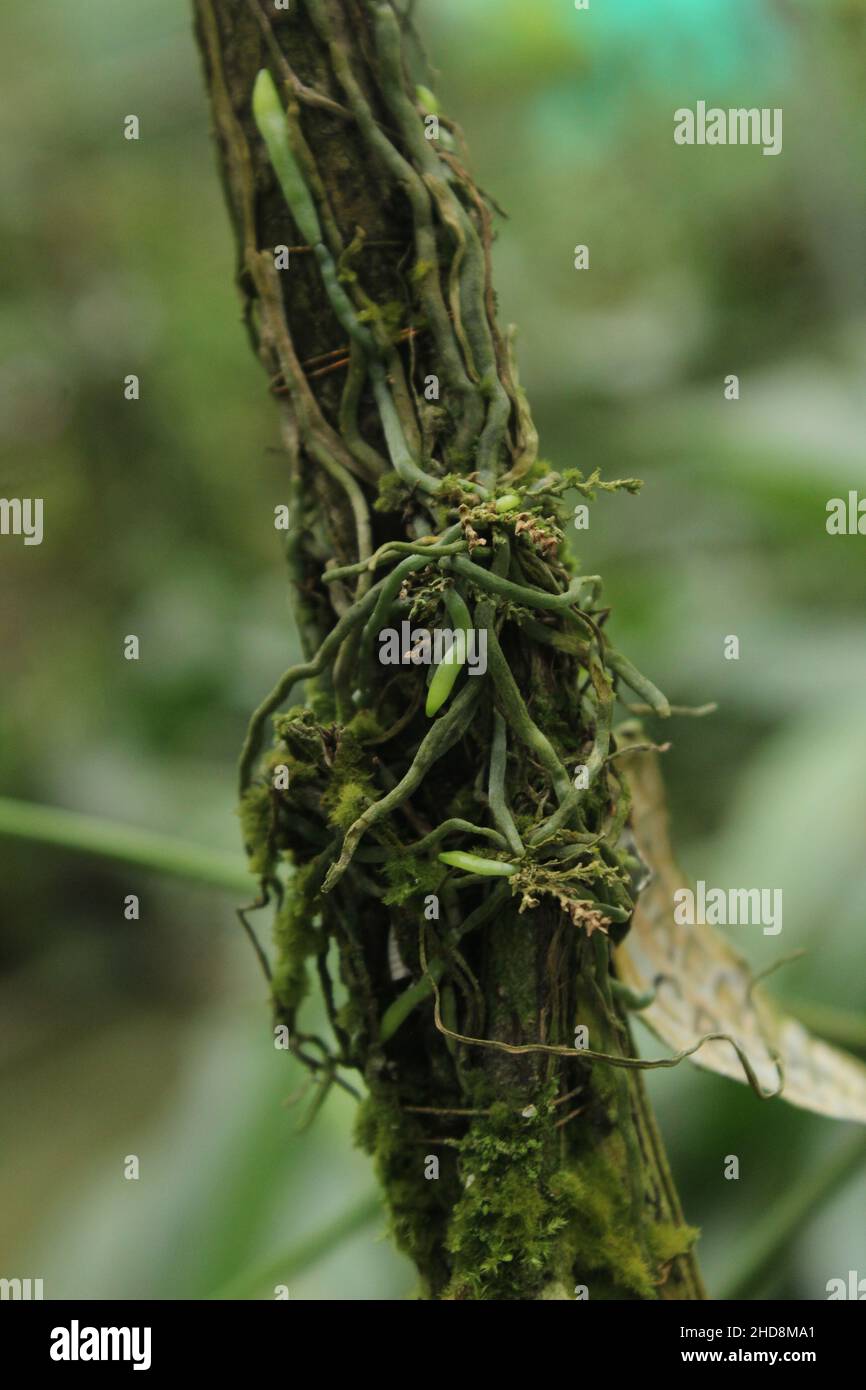 Closeup of worlds smallest orchid. An baby plant of taeniophyllum coxii. ORCHID Costa Rica Platystele jungermannioides World's smallest orchid. Stock Photohttps://www.alamy.com/image-license-details/?v=1https://www.alamy.com/closeup-of-worlds-smallest-orchid-an-baby-plant-of-taeniophyllum-coxii-orchid-costa-rica-platystele-jungermannioides-worlds-smallest-orchid-image455651673.html
Closeup of worlds smallest orchid. An baby plant of taeniophyllum coxii. ORCHID Costa Rica Platystele jungermannioides World's smallest orchid. Stock Photohttps://www.alamy.com/image-license-details/?v=1https://www.alamy.com/closeup-of-worlds-smallest-orchid-an-baby-plant-of-taeniophyllum-coxii-orchid-costa-rica-platystele-jungermannioides-worlds-smallest-orchid-image455651673.htmlRF2HD8MA1–Closeup of worlds smallest orchid. An baby plant of taeniophyllum coxii. ORCHID Costa Rica Platystele jungermannioides World's smallest orchid.
 Western Redcedar nurse stiump supporting new growth of Western Hemlock, at Staircase, Olympic National Park, Washington State, USA Stock Photohttps://www.alamy.com/image-license-details/?v=1https://www.alamy.com/western-redcedar-nurse-stiump-supporting-new-growth-of-western-hemlock-at-staircase-olympic-national-park-washington-state-usa-image619478527.html
Western Redcedar nurse stiump supporting new growth of Western Hemlock, at Staircase, Olympic National Park, Washington State, USA Stock Photohttps://www.alamy.com/image-license-details/?v=1https://www.alamy.com/western-redcedar-nurse-stiump-supporting-new-growth-of-western-hemlock-at-staircase-olympic-national-park-washington-state-usa-image619478527.htmlRF2XYRK53–Western Redcedar nurse stiump supporting new growth of Western Hemlock, at Staircase, Olympic National Park, Washington State, USA
 A detailed close-up of an intricate network of roots and mycelium, showcasing the complexity and beauty of nature's underground structures. The organi Stock Photohttps://www.alamy.com/image-license-details/?v=1https://www.alamy.com/a-detailed-close-up-of-an-intricate-network-of-roots-and-mycelium-showcasing-the-complexity-and-beauty-of-natures-underground-structures-the-organi-image611472885.html
A detailed close-up of an intricate network of roots and mycelium, showcasing the complexity and beauty of nature's underground structures. The organi Stock Photohttps://www.alamy.com/image-license-details/?v=1https://www.alamy.com/a-detailed-close-up-of-an-intricate-network-of-roots-and-mycelium-showcasing-the-complexity-and-beauty-of-natures-underground-structures-the-organi-image611472885.htmlRF2XEPYW9–A detailed close-up of an intricate network of roots and mycelium, showcasing the complexity and beauty of nature's underground structures. The organi
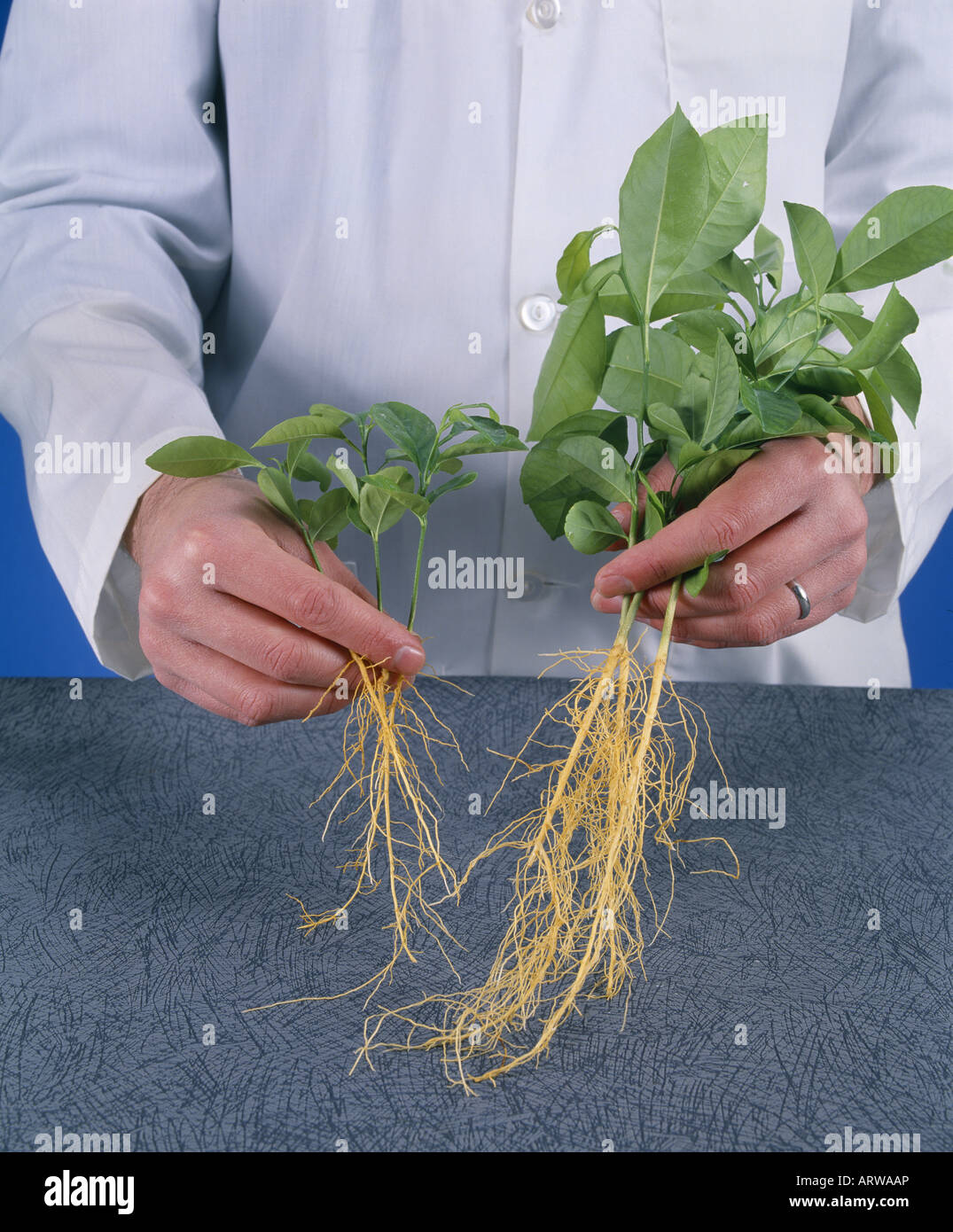 LAB TECHNICIAN COMPARING ROOT SYSTEMS OF LEMON TREES (ON RIGHT) GROWN WITH MYCORRHIZA AND (ON LEFT) GROWN WITHOUT Stock Photohttps://www.alamy.com/image-license-details/?v=1https://www.alamy.com/stock-photo-lab-technician-comparing-root-systems-of-lemon-trees-on-right-grown-16131933.html
LAB TECHNICIAN COMPARING ROOT SYSTEMS OF LEMON TREES (ON RIGHT) GROWN WITH MYCORRHIZA AND (ON LEFT) GROWN WITHOUT Stock Photohttps://www.alamy.com/image-license-details/?v=1https://www.alamy.com/stock-photo-lab-technician-comparing-root-systems-of-lemon-trees-on-right-grown-16131933.htmlRMARWAAP–LAB TECHNICIAN COMPARING ROOT SYSTEMS OF LEMON TREES (ON RIGHT) GROWN WITH MYCORRHIZA AND (ON LEFT) GROWN WITHOUT
 The fly agaric is a symbol of autumn and a popular photographic subject. It captivates with its red color and white spots. Stock Photohttps://www.alamy.com/image-license-details/?v=1https://www.alamy.com/the-fly-agaric-is-a-symbol-of-autumn-and-a-popular-photographic-subject-it-captivates-with-its-red-color-and-white-spots-image572593658.html
The fly agaric is a symbol of autumn and a popular photographic subject. It captivates with its red color and white spots. Stock Photohttps://www.alamy.com/image-license-details/?v=1https://www.alamy.com/the-fly-agaric-is-a-symbol-of-autumn-and-a-popular-photographic-subject-it-captivates-with-its-red-color-and-white-spots-image572593658.htmlRF2T7FW1E–The fly agaric is a symbol of autumn and a popular photographic subject. It captivates with its red color and white spots.
 Vascular plant fine roots looking like a neural network. 3D rendering Stock Photohttps://www.alamy.com/image-license-details/?v=1https://www.alamy.com/vascular-plant-fine-roots-looking-like-a-neural-network-3d-rendering-image357905408.html
Vascular plant fine roots looking like a neural network. 3D rendering Stock Photohttps://www.alamy.com/image-license-details/?v=1https://www.alamy.com/vascular-plant-fine-roots-looking-like-a-neural-network-3d-rendering-image357905408.htmlRF2BP8000–Vascular plant fine roots looking like a neural network. 3D rendering
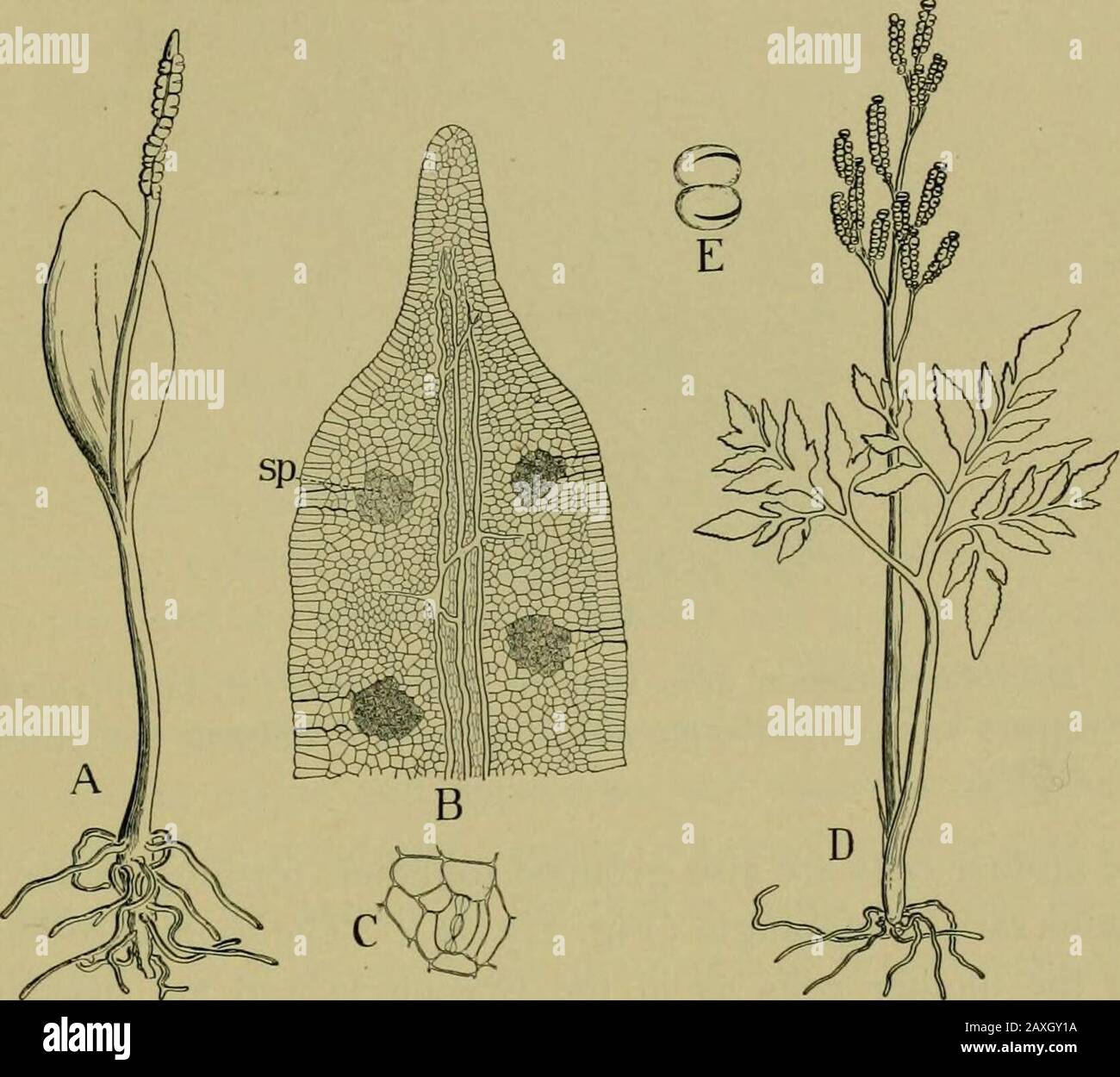 Nature and development of plants . of the Sporophyte.—This order con-tains three genera of very primitive ferns which are probablybut a remnant of an earlier and widely distributed group. Onlytwo, Ophioglossum and Botrychium, are of common occurrence(Fig. 215). They are of unusual interest because they presentmany features suggestive of the liverworts and also of the morespecialized ferns and seed plants. The sporophyte consists ofa short upright stem with thick fleshy roots that are associatedwith mycorrhiza. The leaves are simple or divided and usuallyappear singly, ensheathing the apex of t Stock Photohttps://www.alamy.com/image-license-details/?v=1https://www.alamy.com/nature-and-development-of-plants-of-the-sporophytethis-order-con-tains-three-genera-of-very-primitive-ferns-which-are-probablybut-a-remnant-of-an-earlier-and-widely-distributed-group-onlytwo-ophioglossum-and-botrychium-are-of-common-occurrencefig-215-they-are-of-unusual-interest-because-they-presentmany-features-suggestive-of-the-liverworts-and-also-of-the-morespecialized-ferns-and-seed-plants-the-sporophyte-consists-ofa-short-upright-stem-with-thick-fleshy-roots-that-are-associatedwith-mycorrhiza-the-leaves-are-simple-or-divided-and-usuallyappear-singly-ensheathing-the-apex-of-t-image343350486.html
Nature and development of plants . of the Sporophyte.—This order con-tains three genera of very primitive ferns which are probablybut a remnant of an earlier and widely distributed group. Onlytwo, Ophioglossum and Botrychium, are of common occurrence(Fig. 215). They are of unusual interest because they presentmany features suggestive of the liverworts and also of the morespecialized ferns and seed plants. The sporophyte consists ofa short upright stem with thick fleshy roots that are associatedwith mycorrhiza. The leaves are simple or divided and usuallyappear singly, ensheathing the apex of t Stock Photohttps://www.alamy.com/image-license-details/?v=1https://www.alamy.com/nature-and-development-of-plants-of-the-sporophytethis-order-con-tains-three-genera-of-very-primitive-ferns-which-are-probablybut-a-remnant-of-an-earlier-and-widely-distributed-group-onlytwo-ophioglossum-and-botrychium-are-of-common-occurrencefig-215-they-are-of-unusual-interest-because-they-presentmany-features-suggestive-of-the-liverworts-and-also-of-the-morespecialized-ferns-and-seed-plants-the-sporophyte-consists-ofa-short-upright-stem-with-thick-fleshy-roots-that-are-associatedwith-mycorrhiza-the-leaves-are-simple-or-divided-and-usuallyappear-singly-ensheathing-the-apex-of-t-image343350486.htmlRM2AXGY1A–Nature and development of plants . of the Sporophyte.—This order con-tains three genera of very primitive ferns which are probablybut a remnant of an earlier and widely distributed group. Onlytwo, Ophioglossum and Botrychium, are of common occurrence(Fig. 215). They are of unusual interest because they presentmany features suggestive of the liverworts and also of the morespecialized ferns and seed plants. The sporophyte consists ofa short upright stem with thick fleshy roots that are associatedwith mycorrhiza. The leaves are simple or divided and usuallyappear singly, ensheathing the apex of t
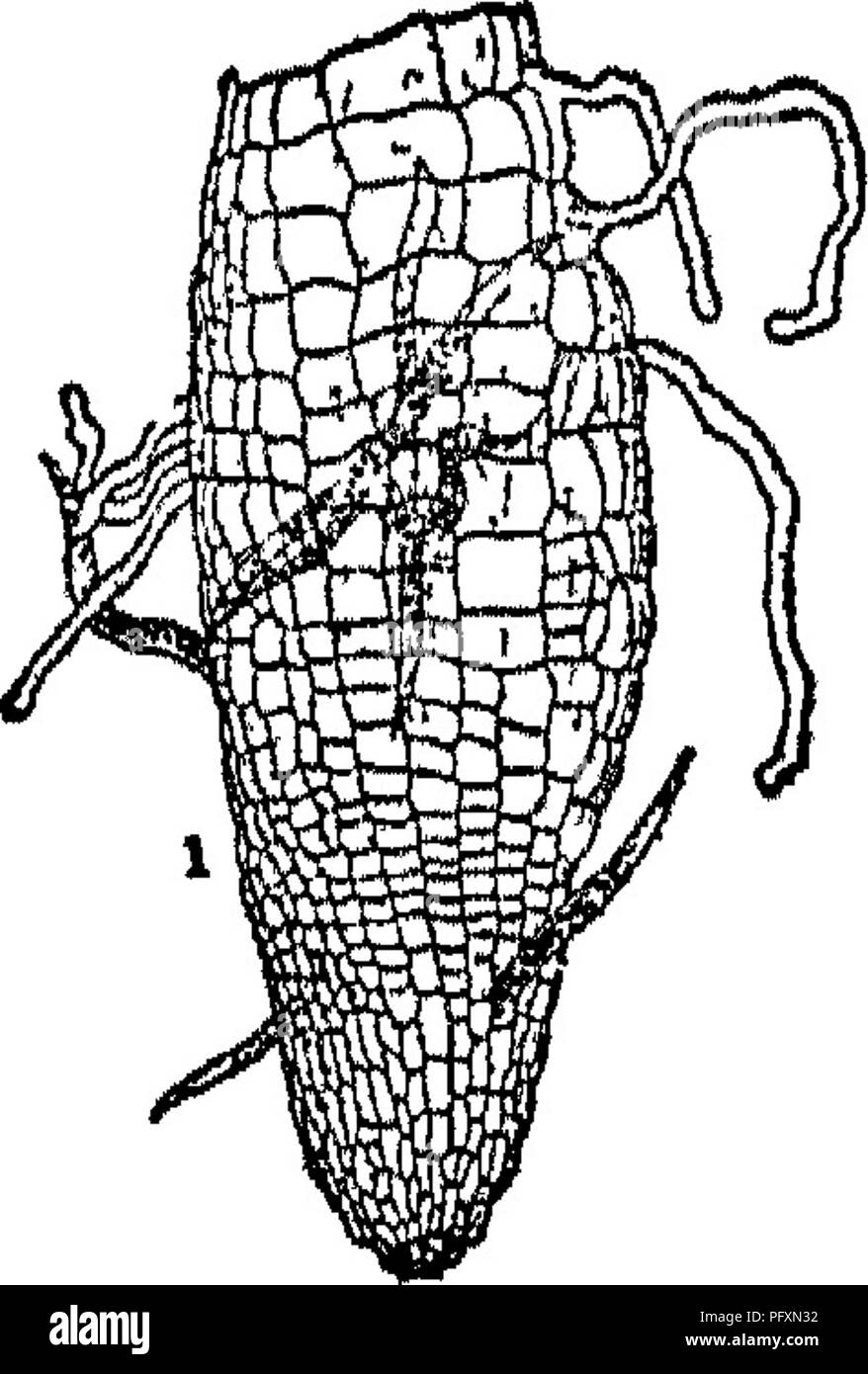 . Soils, their properties and management. Soils. 424 SOILS: PBOPSRTIES AND MANAGEMENT with the myceHa of fungi. It is thought that the mycor- rhiza aid the higher plants to obtain nutriment that they must strive for in competition with the fungi. RIycotrophic plants are also able to grow with a very small transpiration of moisture, as is well known to be the case with many conifers; and this restricted tran- spiration would doubtless result in lack of nutriment were it not for the assistance of the mycorrhiza. 346. Plant roots. — The roots of plants assist in pro- moting productiveness of the Stock Photohttps://www.alamy.com/image-license-details/?v=1https://www.alamy.com/soils-their-properties-and-management-soils-424-soils-pbopsrties-and-management-with-the-myceha-of-fungi-it-is-thought-that-the-mycor-rhiza-aid-the-higher-plants-to-obtain-nutriment-that-they-must-strive-for-in-competition-with-the-fungi-riycotrophic-plants-are-also-able-to-grow-with-a-very-small-transpiration-of-moisture-as-is-well-known-to-be-the-case-with-many-conifers-and-this-restricted-tran-spiration-would-doubtless-result-in-lack-of-nutriment-were-it-not-for-the-assistance-of-the-mycorrhiza-346-plant-roots-the-roots-of-plants-assist-in-pro-moting-productiveness-of-the-image216331558.html
. Soils, their properties and management. Soils. 424 SOILS: PBOPSRTIES AND MANAGEMENT with the myceHa of fungi. It is thought that the mycor- rhiza aid the higher plants to obtain nutriment that they must strive for in competition with the fungi. RIycotrophic plants are also able to grow with a very small transpiration of moisture, as is well known to be the case with many conifers; and this restricted tran- spiration would doubtless result in lack of nutriment were it not for the assistance of the mycorrhiza. 346. Plant roots. — The roots of plants assist in pro- moting productiveness of the Stock Photohttps://www.alamy.com/image-license-details/?v=1https://www.alamy.com/soils-their-properties-and-management-soils-424-soils-pbopsrties-and-management-with-the-myceha-of-fungi-it-is-thought-that-the-mycor-rhiza-aid-the-higher-plants-to-obtain-nutriment-that-they-must-strive-for-in-competition-with-the-fungi-riycotrophic-plants-are-also-able-to-grow-with-a-very-small-transpiration-of-moisture-as-is-well-known-to-be-the-case-with-many-conifers-and-this-restricted-tran-spiration-would-doubtless-result-in-lack-of-nutriment-were-it-not-for-the-assistance-of-the-mycorrhiza-346-plant-roots-the-roots-of-plants-assist-in-pro-moting-productiveness-of-the-image216331558.htmlRMPFXN32–. Soils, their properties and management. Soils. 424 SOILS: PBOPSRTIES AND MANAGEMENT with the myceHa of fungi. It is thought that the mycor- rhiza aid the higher plants to obtain nutriment that they must strive for in competition with the fungi. RIycotrophic plants are also able to grow with a very small transpiration of moisture, as is well known to be the case with many conifers; and this restricted tran- spiration would doubtless result in lack of nutriment were it not for the assistance of the mycorrhiza. 346. Plant roots. — The roots of plants assist in pro- moting productiveness of the
RF2PNGTK5–Botany line icons collection. Photosynthesis, Chlorophyll, Pollination, Stamen, Pistil, Germination, Roots vector and linear illustration. Stem,Leaves
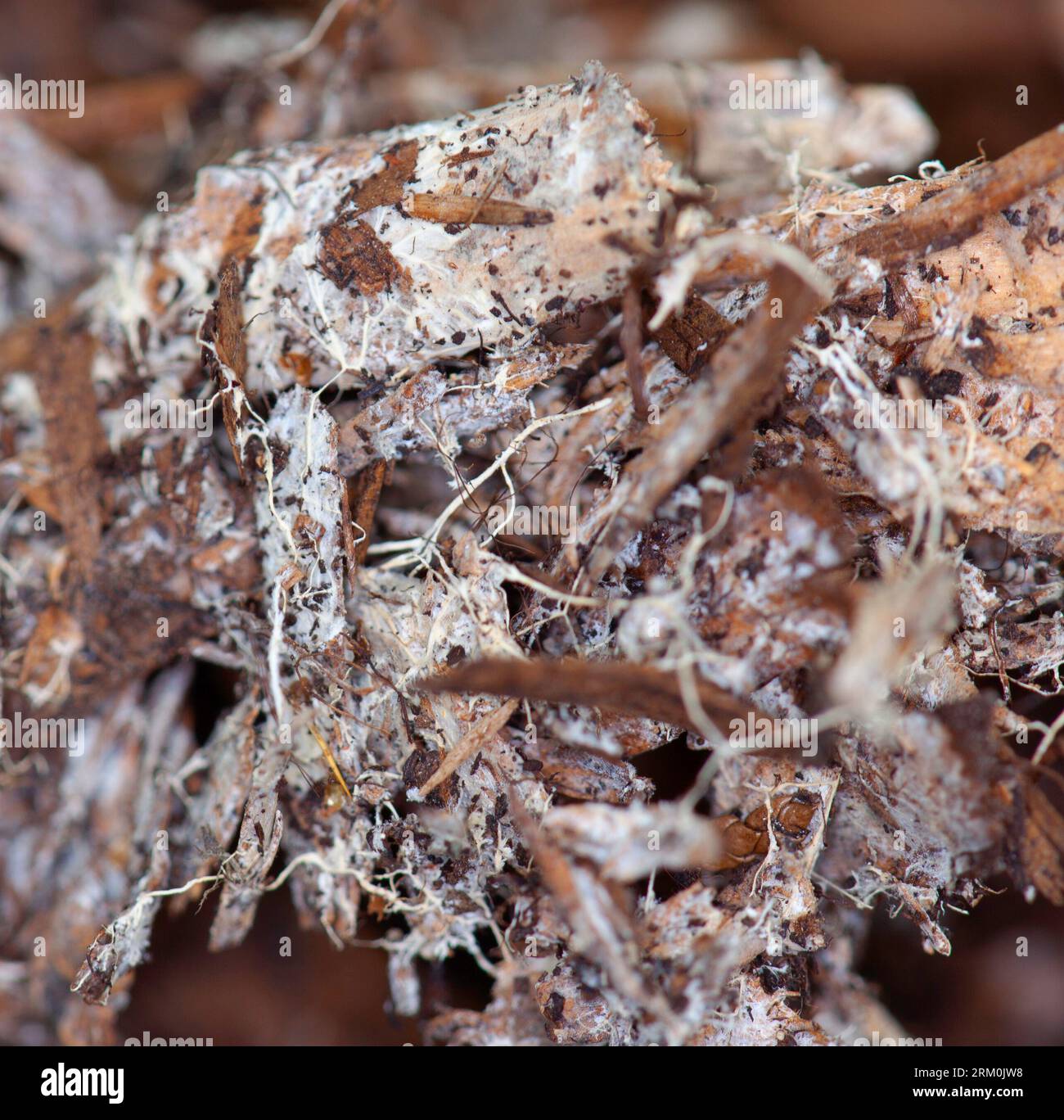 Mycelium Strands around Tomato roots in No Dig compost Stock Photohttps://www.alamy.com/image-license-details/?v=1https://www.alamy.com/mycelium-strands-around-tomato-roots-in-no-dig-compost-image563039716.html
Mycelium Strands around Tomato roots in No Dig compost Stock Photohttps://www.alamy.com/image-license-details/?v=1https://www.alamy.com/mycelium-strands-around-tomato-roots-in-no-dig-compost-image563039716.htmlRF2RM0JW8–Mycelium Strands around Tomato roots in No Dig compost
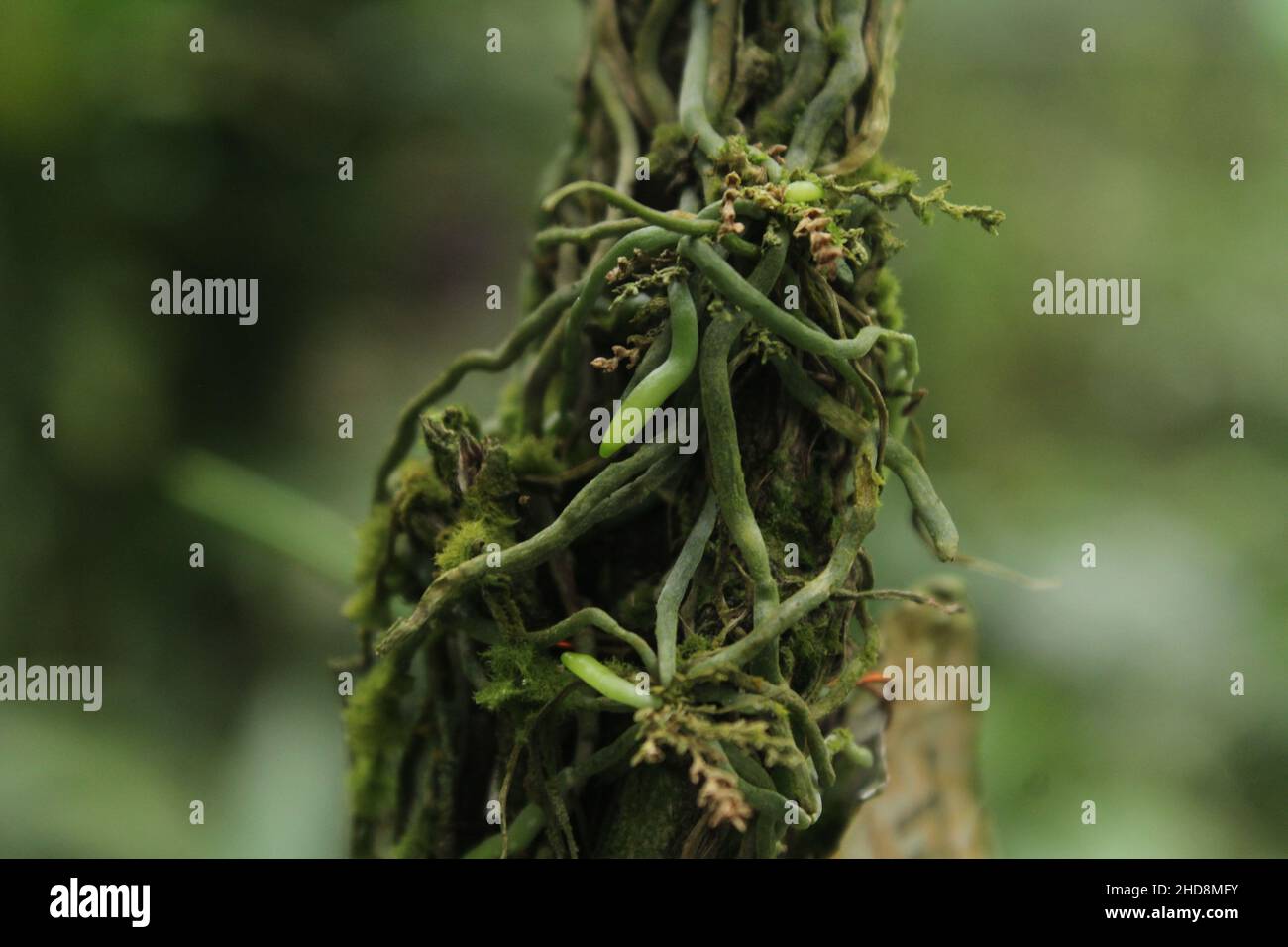 Closeup of worlds smallest orchid. An baby plant of taeniophyllum coxii. ORCHID Costa Rica Platystele jungermannioides World's smallest orchid. Stock Photohttps://www.alamy.com/image-license-details/?v=1https://www.alamy.com/closeup-of-worlds-smallest-orchid-an-baby-plant-of-taeniophyllum-coxii-orchid-costa-rica-platystele-jungermannioides-worlds-smallest-orchid-image455651839.html
Closeup of worlds smallest orchid. An baby plant of taeniophyllum coxii. ORCHID Costa Rica Platystele jungermannioides World's smallest orchid. Stock Photohttps://www.alamy.com/image-license-details/?v=1https://www.alamy.com/closeup-of-worlds-smallest-orchid-an-baby-plant-of-taeniophyllum-coxii-orchid-costa-rica-platystele-jungermannioides-worlds-smallest-orchid-image455651839.htmlRF2HD8MFY–Closeup of worlds smallest orchid. An baby plant of taeniophyllum coxii. ORCHID Costa Rica Platystele jungermannioides World's smallest orchid.
 Western Redcedar nurse stiump supporting new growth of Western Hemlock, at Staircase, Olympic National Park, Washington State, USA Stock Photohttps://www.alamy.com/image-license-details/?v=1https://www.alamy.com/western-redcedar-nurse-stiump-supporting-new-growth-of-western-hemlock-at-staircase-olympic-national-park-washington-state-usa-image619313455.html
Western Redcedar nurse stiump supporting new growth of Western Hemlock, at Staircase, Olympic National Park, Washington State, USA Stock Photohttps://www.alamy.com/image-license-details/?v=1https://www.alamy.com/western-redcedar-nurse-stiump-supporting-new-growth-of-western-hemlock-at-staircase-olympic-national-park-washington-state-usa-image619313455.htmlRM2XYG4HK–Western Redcedar nurse stiump supporting new growth of Western Hemlock, at Staircase, Olympic National Park, Washington State, USA
 The fly agaric is a symbol of autumn and a popular photographic subject. It captivates with its red color and white spots. Stock Photohttps://www.alamy.com/image-license-details/?v=1https://www.alamy.com/the-fly-agaric-is-a-symbol-of-autumn-and-a-popular-photographic-subject-it-captivates-with-its-red-color-and-white-spots-image572593655.html
The fly agaric is a symbol of autumn and a popular photographic subject. It captivates with its red color and white spots. Stock Photohttps://www.alamy.com/image-license-details/?v=1https://www.alamy.com/the-fly-agaric-is-a-symbol-of-autumn-and-a-popular-photographic-subject-it-captivates-with-its-red-color-and-white-spots-image572593655.htmlRF2T7FW1B–The fly agaric is a symbol of autumn and a popular photographic subject. It captivates with its red color and white spots.
 Vascular plant fine roots looking like a neural network. 3D rendering Stock Photohttps://www.alamy.com/image-license-details/?v=1https://www.alamy.com/vascular-plant-fine-roots-looking-like-a-neural-network-3d-rendering-image363704889.html
Vascular plant fine roots looking like a neural network. 3D rendering Stock Photohttps://www.alamy.com/image-license-details/?v=1https://www.alamy.com/vascular-plant-fine-roots-looking-like-a-neural-network-3d-rendering-image363704889.htmlRF2C3M589–Vascular plant fine roots looking like a neural network. 3D rendering
 . Soils, their properties and management. Soils. 424 SOILS: PBOPSRTIES AND MANAGEMENT with the myceHa of fungi. It is thought that the mycor- rhiza aid the higher plants to obtain nutriment that they must strive for in competition with the fungi. RIycotrophic plants are also able to grow with a very small transpiration of moisture, as is well known to be the case with many conifers; and this restricted tran- spiration would doubtless result in lack of nutriment were it not for the assistance of the mycorrhiza. 346. Plant roots. — The roots of plants assist in pro- moting productiveness of the Stock Photohttps://www.alamy.com/image-license-details/?v=1https://www.alamy.com/soils-their-properties-and-management-soils-424-soils-pbopsrties-and-management-with-the-myceha-of-fungi-it-is-thought-that-the-mycor-rhiza-aid-the-higher-plants-to-obtain-nutriment-that-they-must-strive-for-in-competition-with-the-fungi-riycotrophic-plants-are-also-able-to-grow-with-a-very-small-transpiration-of-moisture-as-is-well-known-to-be-the-case-with-many-conifers-and-this-restricted-tran-spiration-would-doubtless-result-in-lack-of-nutriment-were-it-not-for-the-assistance-of-the-mycorrhiza-346-plant-roots-the-roots-of-plants-assist-in-pro-moting-productiveness-of-the-image231932339.html
. Soils, their properties and management. Soils. 424 SOILS: PBOPSRTIES AND MANAGEMENT with the myceHa of fungi. It is thought that the mycor- rhiza aid the higher plants to obtain nutriment that they must strive for in competition with the fungi. RIycotrophic plants are also able to grow with a very small transpiration of moisture, as is well known to be the case with many conifers; and this restricted tran- spiration would doubtless result in lack of nutriment were it not for the assistance of the mycorrhiza. 346. Plant roots. — The roots of plants assist in pro- moting productiveness of the Stock Photohttps://www.alamy.com/image-license-details/?v=1https://www.alamy.com/soils-their-properties-and-management-soils-424-soils-pbopsrties-and-management-with-the-myceha-of-fungi-it-is-thought-that-the-mycor-rhiza-aid-the-higher-plants-to-obtain-nutriment-that-they-must-strive-for-in-competition-with-the-fungi-riycotrophic-plants-are-also-able-to-grow-with-a-very-small-transpiration-of-moisture-as-is-well-known-to-be-the-case-with-many-conifers-and-this-restricted-tran-spiration-would-doubtless-result-in-lack-of-nutriment-were-it-not-for-the-assistance-of-the-mycorrhiza-346-plant-roots-the-roots-of-plants-assist-in-pro-moting-productiveness-of-the-image231932339.htmlRMRD9C1R–. Soils, their properties and management. Soils. 424 SOILS: PBOPSRTIES AND MANAGEMENT with the myceHa of fungi. It is thought that the mycor- rhiza aid the higher plants to obtain nutriment that they must strive for in competition with the fungi. RIycotrophic plants are also able to grow with a very small transpiration of moisture, as is well known to be the case with many conifers; and this restricted tran- spiration would doubtless result in lack of nutriment were it not for the assistance of the mycorrhiza. 346. Plant roots. — The roots of plants assist in pro- moting productiveness of the
RF2PNM9N8–Roots line icons collection. Growth, Foundation, Anchorage, System, Base, Origin, Plant vector and linear illustration. Underground,Nerk,Stability
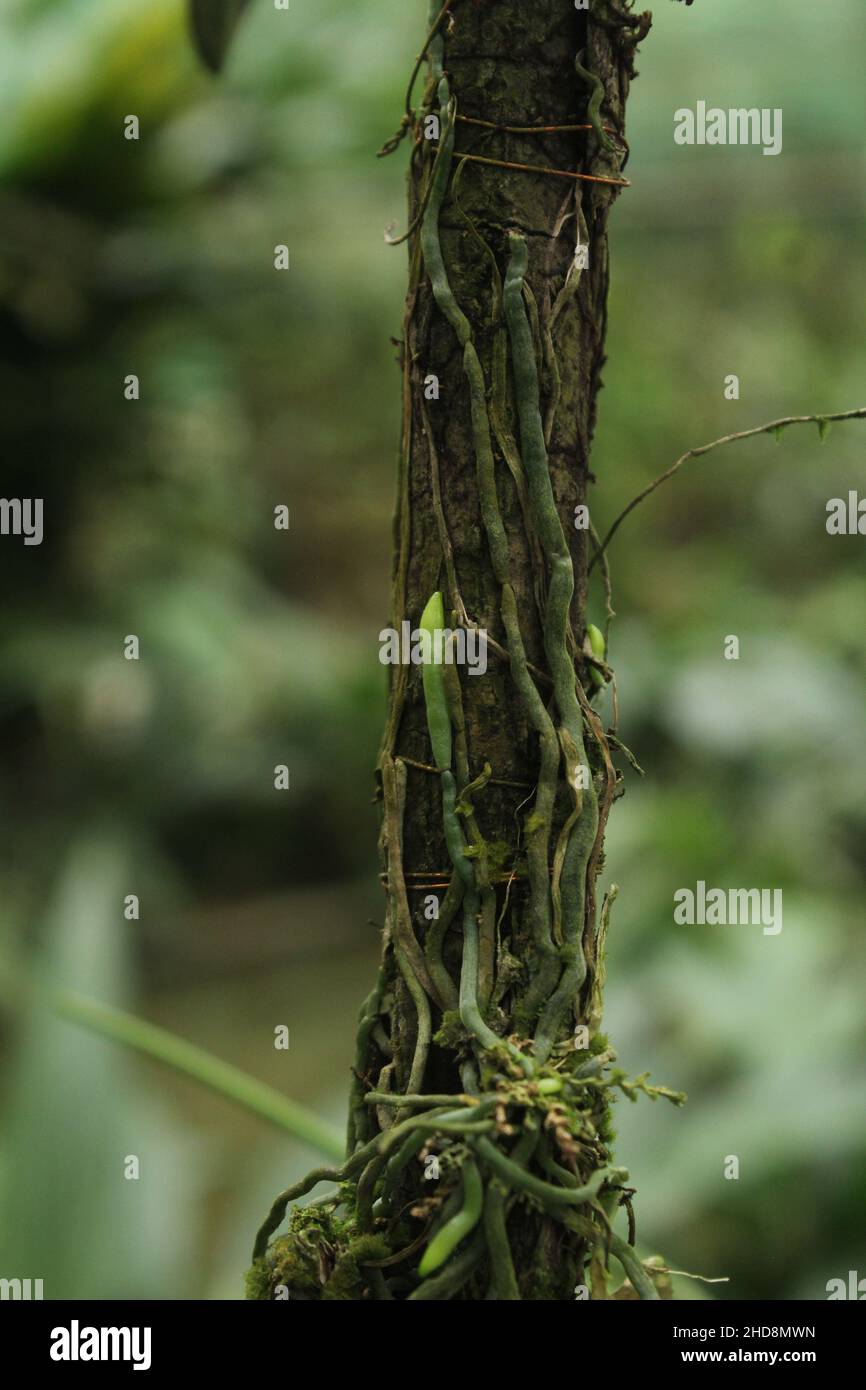 Closeup of worlds smallest orchid. An baby plant of taeniophyllum coxii. ORCHID Costa Rica Platystele jungermannioides World's smallest orchid. Stock Photohttps://www.alamy.com/image-license-details/?v=1https://www.alamy.com/closeup-of-worlds-smallest-orchid-an-baby-plant-of-taeniophyllum-coxii-orchid-costa-rica-platystele-jungermannioides-worlds-smallest-orchid-image455652113.html
Closeup of worlds smallest orchid. An baby plant of taeniophyllum coxii. ORCHID Costa Rica Platystele jungermannioides World's smallest orchid. Stock Photohttps://www.alamy.com/image-license-details/?v=1https://www.alamy.com/closeup-of-worlds-smallest-orchid-an-baby-plant-of-taeniophyllum-coxii-orchid-costa-rica-platystele-jungermannioides-worlds-smallest-orchid-image455652113.htmlRF2HD8MWN–Closeup of worlds smallest orchid. An baby plant of taeniophyllum coxii. ORCHID Costa Rica Platystele jungermannioides World's smallest orchid.
 Western Redcedar nurse stiump supporting new growth of Western Hemlock, at Staircase, Olympic National Park, Washington State, USA Stock Photohttps://www.alamy.com/image-license-details/?v=1https://www.alamy.com/western-redcedar-nurse-stiump-supporting-new-growth-of-western-hemlock-at-staircase-olympic-national-park-washington-state-usa-image619342042.html
Western Redcedar nurse stiump supporting new growth of Western Hemlock, at Staircase, Olympic National Park, Washington State, USA Stock Photohttps://www.alamy.com/image-license-details/?v=1https://www.alamy.com/western-redcedar-nurse-stiump-supporting-new-growth-of-western-hemlock-at-staircase-olympic-national-park-washington-state-usa-image619342042.htmlRM2XYHD2J–Western Redcedar nurse stiump supporting new growth of Western Hemlock, at Staircase, Olympic National Park, Washington State, USA
 Vascular plant fine roots looking like a neural network. 3D rendering Stock Photohttps://www.alamy.com/image-license-details/?v=1https://www.alamy.com/vascular-plant-fine-roots-looking-like-a-neural-network-3d-rendering-image368143123.html
Vascular plant fine roots looking like a neural network. 3D rendering Stock Photohttps://www.alamy.com/image-license-details/?v=1https://www.alamy.com/vascular-plant-fine-roots-looking-like-a-neural-network-3d-rendering-image368143123.htmlRF2CAXA8K–Vascular plant fine roots looking like a neural network. 3D rendering
 . Introduction to botany. Botany. 52 INTRODUCTION TO BOTANY saprophytes have fungi growing upon their roots in such ways as to assist in securing food. These are called symbiotic sapro- phytes. The Indian pipe (^Monotropa) often has these root fungi (mycorrhiza). Partial saprophytes, among flowering plants, are not easily recognized by their form and color, but may be known by their inability to flourish without considerable humus in the soil. 52. Parasites. The dodders are the most familiar flower- ing parasites. One of the commonest species is abundant in the central and north- eastern state Stock Photohttps://www.alamy.com/image-license-details/?v=1https://www.alamy.com/introduction-to-botany-botany-52-introduction-to-botany-saprophytes-have-fungi-growing-upon-their-roots-in-such-ways-as-to-assist-in-securing-food-these-are-called-symbiotic-sapro-phytes-the-indian-pipe-monotropa-often-has-these-root-fungi-mycorrhiza-partial-saprophytes-among-flowering-plants-are-not-easily-recognized-by-their-form-and-color-but-may-be-known-by-their-inability-to-flourish-without-considerable-humus-in-the-soil-52-parasites-the-dodders-are-the-most-familiar-flower-ing-parasites-one-of-the-commonest-species-is-abundant-in-the-central-and-north-eastern-state-image232414275.html
. Introduction to botany. Botany. 52 INTRODUCTION TO BOTANY saprophytes have fungi growing upon their roots in such ways as to assist in securing food. These are called symbiotic sapro- phytes. The Indian pipe (^Monotropa) often has these root fungi (mycorrhiza). Partial saprophytes, among flowering plants, are not easily recognized by their form and color, but may be known by their inability to flourish without considerable humus in the soil. 52. Parasites. The dodders are the most familiar flower- ing parasites. One of the commonest species is abundant in the central and north- eastern state Stock Photohttps://www.alamy.com/image-license-details/?v=1https://www.alamy.com/introduction-to-botany-botany-52-introduction-to-botany-saprophytes-have-fungi-growing-upon-their-roots-in-such-ways-as-to-assist-in-securing-food-these-are-called-symbiotic-sapro-phytes-the-indian-pipe-monotropa-often-has-these-root-fungi-mycorrhiza-partial-saprophytes-among-flowering-plants-are-not-easily-recognized-by-their-form-and-color-but-may-be-known-by-their-inability-to-flourish-without-considerable-humus-in-the-soil-52-parasites-the-dodders-are-the-most-familiar-flower-ing-parasites-one-of-the-commonest-species-is-abundant-in-the-central-and-north-eastern-state-image232414275.htmlRMRE3ANR–. Introduction to botany. Botany. 52 INTRODUCTION TO BOTANY saprophytes have fungi growing upon their roots in such ways as to assist in securing food. These are called symbiotic sapro- phytes. The Indian pipe (^Monotropa) often has these root fungi (mycorrhiza). Partial saprophytes, among flowering plants, are not easily recognized by their form and color, but may be known by their inability to flourish without considerable humus in the soil. 52. Parasites. The dodders are the most familiar flower- ing parasites. One of the commonest species is abundant in the central and north- eastern state
 Western Redcedar nurse stiump supporting new growth of Western Hemlock, at Staircase, Olympic National Park, Washington State, USA Stock Photohttps://www.alamy.com/image-license-details/?v=1https://www.alamy.com/western-redcedar-nurse-stiump-supporting-new-growth-of-western-hemlock-at-staircase-olympic-national-park-washington-state-usa-image619313088.html
Western Redcedar nurse stiump supporting new growth of Western Hemlock, at Staircase, Olympic National Park, Washington State, USA Stock Photohttps://www.alamy.com/image-license-details/?v=1https://www.alamy.com/western-redcedar-nurse-stiump-supporting-new-growth-of-western-hemlock-at-staircase-olympic-national-park-washington-state-usa-image619313088.htmlRM2XYG44G–Western Redcedar nurse stiump supporting new growth of Western Hemlock, at Staircase, Olympic National Park, Washington State, USA
 . Bulletin. Agriculture. 44 EXPERIMENTS IN BLUEBERRY CULTURE. as occurs on the roots of oaks. In the latter type of mycorrhiza the hypha^ of the fungus form a dense sheath around the rootlet, com- pletely shutting it off from direct contact with the surrounding soil. The loose hypha' on the outside of the sheath resemble root hairs and it is supposed to be a part of their function to absorb soil mois- ture and transmit it to the oak rootlet just as root hairs do. It has not yet been possible, for want of time, to study the life history of this mycorrhizal fungus of the blueberry. There is, how Stock Photohttps://www.alamy.com/image-license-details/?v=1https://www.alamy.com/bulletin-agriculture-44-experiments-in-blueberry-culture-as-occurs-on-the-roots-of-oaks-in-the-latter-type-of-mycorrhiza-the-hypha-of-the-fungus-form-a-dense-sheath-around-the-rootlet-com-pletely-shutting-it-off-from-direct-contact-with-the-surrounding-soil-the-loose-hypha-on-the-outside-of-the-sheath-resemble-root-hairs-and-it-is-supposed-to-be-a-part-of-their-function-to-absorb-soil-mois-ture-and-transmit-it-to-the-oak-rootlet-just-as-root-hairs-do-it-has-not-yet-been-possible-for-want-of-time-to-study-the-life-history-of-this-mycorrhizal-fungus-of-the-blueberry-there-is-how-image234204422.html
. Bulletin. Agriculture. 44 EXPERIMENTS IN BLUEBERRY CULTURE. as occurs on the roots of oaks. In the latter type of mycorrhiza the hypha^ of the fungus form a dense sheath around the rootlet, com- pletely shutting it off from direct contact with the surrounding soil. The loose hypha' on the outside of the sheath resemble root hairs and it is supposed to be a part of their function to absorb soil mois- ture and transmit it to the oak rootlet just as root hairs do. It has not yet been possible, for want of time, to study the life history of this mycorrhizal fungus of the blueberry. There is, how Stock Photohttps://www.alamy.com/image-license-details/?v=1https://www.alamy.com/bulletin-agriculture-44-experiments-in-blueberry-culture-as-occurs-on-the-roots-of-oaks-in-the-latter-type-of-mycorrhiza-the-hypha-of-the-fungus-form-a-dense-sheath-around-the-rootlet-com-pletely-shutting-it-off-from-direct-contact-with-the-surrounding-soil-the-loose-hypha-on-the-outside-of-the-sheath-resemble-root-hairs-and-it-is-supposed-to-be-a-part-of-their-function-to-absorb-soil-mois-ture-and-transmit-it-to-the-oak-rootlet-just-as-root-hairs-do-it-has-not-yet-been-possible-for-want-of-time-to-study-the-life-history-of-this-mycorrhizal-fungus-of-the-blueberry-there-is-how-image234204422.htmlRMRH0X3J–. Bulletin. Agriculture. 44 EXPERIMENTS IN BLUEBERRY CULTURE. as occurs on the roots of oaks. In the latter type of mycorrhiza the hypha^ of the fungus form a dense sheath around the rootlet, com- pletely shutting it off from direct contact with the surrounding soil. The loose hypha' on the outside of the sheath resemble root hairs and it is supposed to be a part of their function to absorb soil mois- ture and transmit it to the oak rootlet just as root hairs do. It has not yet been possible, for want of time, to study the life history of this mycorrhizal fungus of the blueberry. There is, how
 . Bulletin. 1901-13. Agriculture; Agriculture. 44 EXPERIMENTS IN BLUEBERRY CULTURE. as occurs on the roots of oaks. In the latter type of mycorrhiza the hyphse of the fungus form a dense sheath around the rootlet, com- pletely shutting it off from direct contact with the surrounding soil. The loose hyphse on the outside of the sheath resemble root hairs and it is supposed to be a part of their function to absorb soil mois- ture and transmit it to the oak rootlet just as root hairs do. It has not yet been possible, for want of time, to study the life history of this mycorrhizal fungus of the bl Stock Photohttps://www.alamy.com/image-license-details/?v=1https://www.alamy.com/bulletin-1901-13-agriculture-agriculture-44-experiments-in-blueberry-culture-as-occurs-on-the-roots-of-oaks-in-the-latter-type-of-mycorrhiza-the-hyphse-of-the-fungus-form-a-dense-sheath-around-the-rootlet-com-pletely-shutting-it-off-from-direct-contact-with-the-surrounding-soil-the-loose-hyphse-on-the-outside-of-the-sheath-resemble-root-hairs-and-it-is-supposed-to-be-a-part-of-their-function-to-absorb-soil-mois-ture-and-transmit-it-to-the-oak-rootlet-just-as-root-hairs-do-it-has-not-yet-been-possible-for-want-of-time-to-study-the-life-history-of-this-mycorrhizal-fungus-of-the-bl-image234112960.html
. Bulletin. 1901-13. Agriculture; Agriculture. 44 EXPERIMENTS IN BLUEBERRY CULTURE. as occurs on the roots of oaks. In the latter type of mycorrhiza the hyphse of the fungus form a dense sheath around the rootlet, com- pletely shutting it off from direct contact with the surrounding soil. The loose hyphse on the outside of the sheath resemble root hairs and it is supposed to be a part of their function to absorb soil mois- ture and transmit it to the oak rootlet just as root hairs do. It has not yet been possible, for want of time, to study the life history of this mycorrhizal fungus of the bl Stock Photohttps://www.alamy.com/image-license-details/?v=1https://www.alamy.com/bulletin-1901-13-agriculture-agriculture-44-experiments-in-blueberry-culture-as-occurs-on-the-roots-of-oaks-in-the-latter-type-of-mycorrhiza-the-hyphse-of-the-fungus-form-a-dense-sheath-around-the-rootlet-com-pletely-shutting-it-off-from-direct-contact-with-the-surrounding-soil-the-loose-hyphse-on-the-outside-of-the-sheath-resemble-root-hairs-and-it-is-supposed-to-be-a-part-of-their-function-to-absorb-soil-mois-ture-and-transmit-it-to-the-oak-rootlet-just-as-root-hairs-do-it-has-not-yet-been-possible-for-want-of-time-to-study-the-life-history-of-this-mycorrhizal-fungus-of-the-bl-image234112960.htmlRMRGTND4–. Bulletin. 1901-13. Agriculture; Agriculture. 44 EXPERIMENTS IN BLUEBERRY CULTURE. as occurs on the roots of oaks. In the latter type of mycorrhiza the hyphse of the fungus form a dense sheath around the rootlet, com- pletely shutting it off from direct contact with the surrounding soil. The loose hyphse on the outside of the sheath resemble root hairs and it is supposed to be a part of their function to absorb soil mois- ture and transmit it to the oak rootlet just as root hairs do. It has not yet been possible, for want of time, to study the life history of this mycorrhizal fungus of the bl